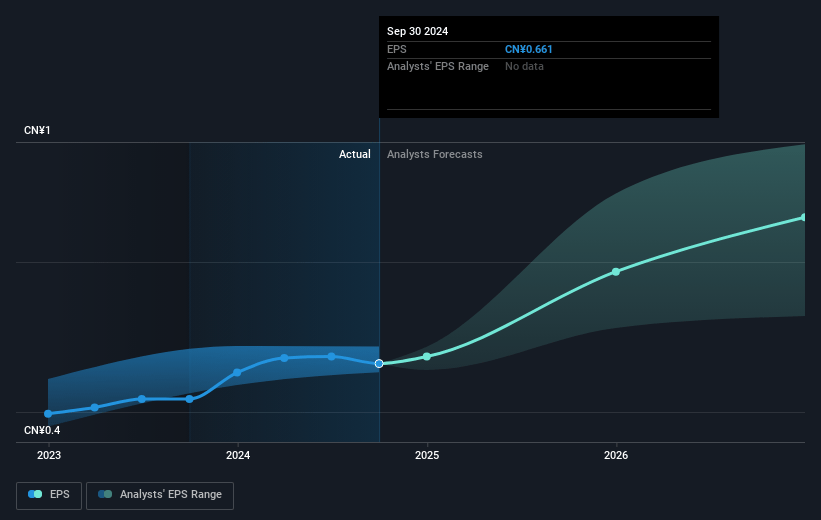Key Takeaways
- Expansion into new markets and the 1+2+N strategy aims to boost revenue growth and improve margins through diversification.
- Strategic debt reduction and improved dividend payouts are focused on optimizing cash flow and enhancing shareholder returns.
- Severe weather, decreased overseas contracts, facility overhauls, tax disputes, and outsourcing expenses pose risks to revenue growth and profit margins.
Catalysts
About China Oilfield Services- Provides integrated oilfield services in China, Indonesia, Mexico, Norway, Rest of Middle East, and internationally.
- The technology segment is expected to see increased investment in high-temperature and high-pressure equipment, enhancing its scale and profitability, which should positively impact both revenue and net margins.
- International contract values are projected to rise significantly in 2025, which could lead to substantial revenue growth in the overseas market.
- The expansion into new markets, specifically in Southeast Asia and the Middle East, guided by the 1+2+N strategy, positions the company for enhanced revenue growth and margin improvement through diversified income streams.
- The marine support services segment is focusing on operational innovation and competitive enhancement, aiming for increased profitability and stronger business status, thereby potentially improving overall net margins.
- Strategic debt reduction and liabilities management, combined with a focus on incrementally improving dividend payouts, is designed to optimize cash flow and raise shareholder returns, which can positively influence earnings per share.
China Oilfield Services Future Earnings and Revenue Growth
Assumptions
How have these above catalysts been quantified?- Analysts are assuming China Oilfield Services's revenue will grow by 4.4% annually over the next 3 years.
- Analysts assume that profit margins will increase from 6.5% today to 8.8% in 3 years time.
- Analysts expect earnings to reach CN¥4.8 billion (and earnings per share of CN¥1.02) by about April 2028, up from CN¥3.1 billion today. However, there is a considerable amount of disagreement amongst the analysts with the most bullish expecting CN¥5.7 billion in earnings, and the most bearish expecting CN¥3.7 billion.
- In order for the above numbers to justify the analysts price target, the company would need to trade at a PE ratio of 11.4x on those 2028 earnings, up from 8.3x today. This future PE is greater than the current PE for the HK Energy Services industry at 10.4x.
- Analysts expect the number of shares outstanding to remain consistent over the next 3 years.
- To value all of this in today's terms, we will use a discount rate of 8.54%, as per the Simply Wall St company report.
China Oilfield Services Future Earnings Per Share Growth
Risks
What could happen that would invalidate this narrative?- The impact of severe weather conditions, such as the numerous typhoons mentioned in 2024, could disrupt operations and decrease revenue in the drilling services segment.
- The decrease in newly signed overseas contracts, with a year-on-year decrease in contract value to USD 1.36 billion, raises concerns about future revenue growth and earnings potential, particularly if international demand does not rebound as anticipated.
- Operations were negatively affected by facility overhauls and revamps in regions such as Norway, which escalated expenses, indicating potential risks to operating margins and earnings unless these are managed more efficiently in the future.
- Tax disputes in global operations, such as those with Mexico, have led to provisions being made, and continued tax issues could constrain net profit margins and lead to unpredictability in financial outcomes.
- Although revenue grew by 20% in the marine support and services segment, higher outsourcing expenses resulted in lower profit growth compared to revenue growth, indicating potential pressure on net margins if cost control is not improved.
Valuation
How have all the factors above been brought together to estimate a fair value?- The analysts have a consensus price target of HK$9.659 for China Oilfield Services based on their expectations of its future earnings growth, profit margins and other risk factors. However, there is a degree of disagreement amongst analysts, with the most bullish reporting a price target of HK$11.98, and the most bearish reporting a price target of just HK$7.92.
- In order for you to agree with the analyst's consensus, you'd need to believe that by 2028, revenues will be CN¥54.9 billion, earnings will come to CN¥4.8 billion, and it would be trading on a PE ratio of 11.4x, assuming you use a discount rate of 8.5%.
- Given the current share price of HK$5.79, the analyst price target of HK$9.66 is 40.1% higher.
- We always encourage you to reach your own conclusions though. So sense check these analyst numbers against your own assumptions and expectations based on your understanding of the business and what you believe is probable.
How well do narratives help inform your perspective?
Disclaimer
Warren A.I. is a tool utilizing a Large Language Model (LLM) that ingests data on consensus price targets, forecasted revenue and earnings figures, as well as the transcripts of earnings calls to produce qualitative analysis. The narratives produced by Warren A.I. are general in nature and are based solely on analyst data and publicly-available material published by the respective companies. These scenarios are not indicative of the company's future performance and are exploratory in nature. Simply Wall St has no position in the company(s) mentioned. Simply Wall St may provide the securities issuer or related entities with website advertising services for a fee, on an arm's length basis. These relationships have no impact on the way we conduct our business, the content we host, or how our content is served to users. The price targets and estimates used are consensus data, and do not constitute a recommendation to buy or sell any stock, and they do not take account of your objectives, or your financial situation. Note that Warren A.I.'s analysis may not factor in the latest price-sensitive company announcements or qualitative material.




